曼昆中级宏观经济学(英文)(1)
- 格式:pdf
- 大小:6.23 MB
- 文档页数:46
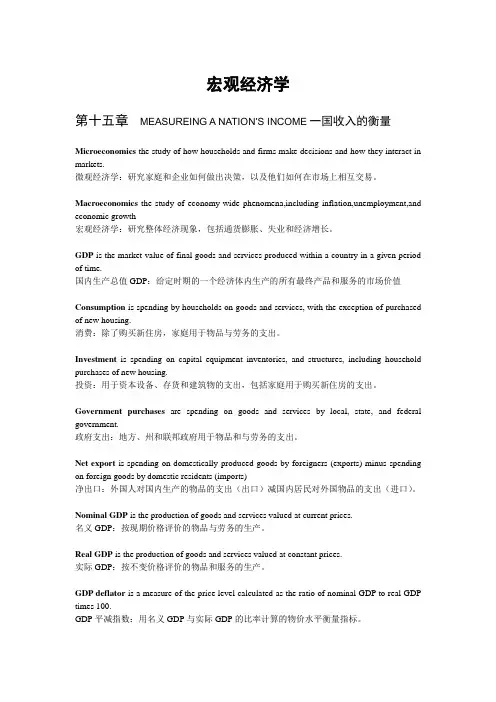
宏观经济学第十五章MEASUREING A NATION’S INCOME一国收入的衡量Microeconomics the study of how households and firms make decisions and how they interact in markets.微观经济学:研究家庭和企业如何做出决策,以及他们如何在市场上相互交易。
Macroeconomics the study of economy-wide phenomena,including inflation,unemployment,and economic growth宏观经济学:研究整体经济现象,包括通货膨胀、失业和经济增长。
GDP is the market value of final goods and services produced within a country in a given period of time.国内生产总值GDP:给定时期的一个经济体内生产的所有最终产品和服务的市场价值Consumption is spending by households on goods and services, with the exception of purchased of new housing.消费:除了购买新住房,家庭用于物品与劳务的支出。
Investment is spending on capital equipment inventories, and structures, including household purchases of new housing.投资:用于资本设备、存货和建筑物的支出,包括家庭用于购买新住房的支出。
Government purchases are spending on goods and services by local, state, and federal government.政府支出:地方、州和联邦政府用于物品和与劳务的支出。

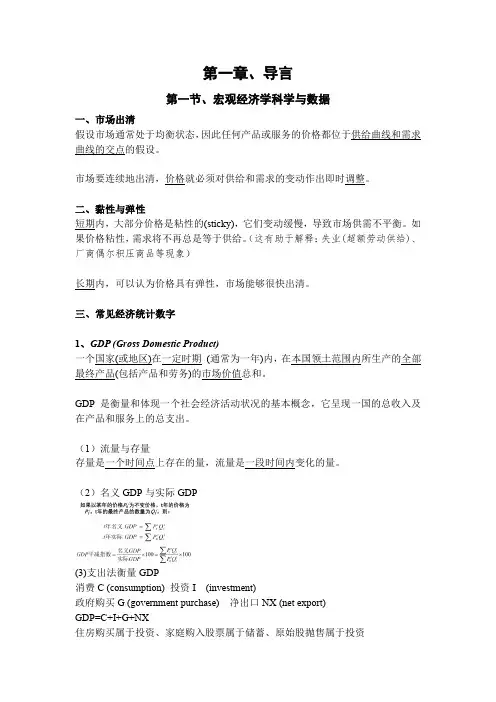
第一章、导言第一节、宏观经济学科学与数据一、市场出清假设市场通常处于均衡状态,因此任何产品或服务的价格都位于供给曲线和需求曲线的交点的假设。
市场要连续地出清,价格就必须对供给和需求的变动作出即时调整。
二、黏性与弹性短期内,大部分价格是粘性的(sticky),它们变动缓慢,导致市场供需不平衡。
如果价格粘性,需求将不再总是等于供给。
(这有助于解释:失业(超额劳动供给)、厂商偶尔积压商品等现象)长期内,可以认为价格具有弹性,市场能够很快出清。
三、常见经济统计数字1、GDP (Gross Domestic Product)一个国家(或地区)在一定时期(通常为一年)内,在本国领土范围内所生产的全部最终产品(包括产品和劳务)的市场价值总和。
GDP是衡量和体现一个社会经济活动状况的基本概念,它呈现一国的总收入及在产品和服务上的总支出。
(1)流量与存量存量是一个时间点上存在的量,流量是一段时间内变化的量。
(2)名义GDP与实际GDP(3)支出法衡量GDP消费C (consumption) 投资I (investment)政府购买G (government purchase) 净出口NX (net export)GDP=C+I+G+NX住房购买属于投资、家庭购入股票属于储蓄、原始股抛售属于投资1)投资包括企业固定投资、住房固定投资和存货投资(3)收入法计算GDPGNP=GDP+来自国外的要素报酬-支付给国外的要素报酬▪NNP=GNP-折旧▪国民收入=NNP-统计误差个人收入= 国民收入-间接企业税-公司利润-社会保险费-净利息+股息+政府对个人的转移支付+个人利息收入个人可支配收入=个人收入-个人税收和非税收支付2、CPI (consumer price index)对一个固定的消费品篮子价格的衡量,主要反映消费者支付商品和劳务的价格变化情况,也是一种度量通货膨胀的工具,以百分比变化为表达形式。
CPI与GDP平减指数(1) CPI衡量价格时所涉及的是消费者购买的所有物品和服务。

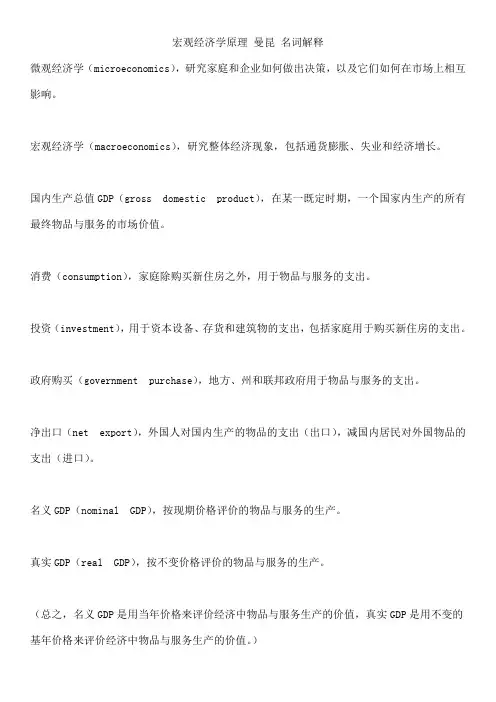
宏观经济学原理曼昆名词解释微观经济学(microeconomics),研究家庭和企业如何做出决策,以及它们如何在市场上相互影响。
宏观经济学(macroeconomics),研究整体经济现象,包括通货膨胀、失业和经济增长。
国内生产总值GDP(gross domestic product),在某一既定时期,一个国家内生产的所有最终物品与服务的市场价值。
消费(consumption),家庭除购买新住房之外,用于物品与服务的支出。
投资(investment),用于资本设备、存货和建筑物的支出,包括家庭用于购买新住房的支出。
政府购买(government purchase),地方、州和联邦政府用于物品与服务的支出。
净出口(net export),外国人对国内生产的物品的支出(出口),减国内居民对外国物品的支出(进口)。
名义GDP(nominal GDP),按现期价格评价的物品与服务的生产。
真实GDP(real GDP),按不变价格评价的物品与服务的生产。
(总之,名义GDP是用当年价格来评价经济中物品与服务生产的价值,真实GDP是用不变的GDP平减指数(GDP, deflator),用名义GDP与真实GDP的比率乘以100计算的物价水平衡量指标。
消费物价指数CPI(consumer price index),普通消费者所购买的物品与服务的总费用的衡量指标。
通货膨胀率(inflation rate),从前一个时期以来,物价指数变动的百分比。
生产物价指数(producer price index),企业所购买的一篮子物品运服务的费用的衡量指标。
指数化(indexation),根据法律或合同按照通货膨胀的影响,对货币数量的自动调整。
名义利率(nominal interest rate),通常公布的、未根据通货膨胀的影响,校正的利率。
真实利率(real interest rate),根据通货膨胀的影响校正过的利率。
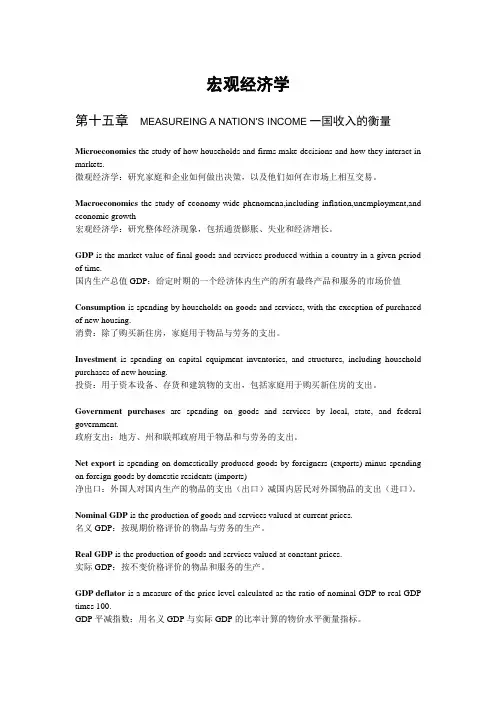
宏观经济学第十五章MEASUREING A NATION’S INCOME一国收入的衡量Microeconomics the study of how households and firms make decisions and how they interact in markets.微观经济学:研究家庭和企业如何做出决策,以及他们如何在市场上相互交易。
Macroeconomics the study of economy-wide phenomena,including inflation,unemployment,and economic growth宏观经济学:研究整体经济现象,包括通货膨胀、失业和经济增长。
GDP is the market value of final goods and services produced within a country in a given period of time.国内生产总值GDP:给定时期的一个经济体内生产的所有最终产品和服务的市场价值Consumption is spending by households on goods and services, with the exception of purchased of new housing.消费:除了购买新住房,家庭用于物品与劳务的支出。
Investment is spending on capital equipment inventories, and structures, including household purchases of new housing.投资:用于资本设备、存货和建筑物的支出,包括家庭用于购买新住房的支出。
Government purchases are spending on goods and services by local, state, and federal government.政府支出:地方、州和联邦政府用于物品和与劳务的支出。

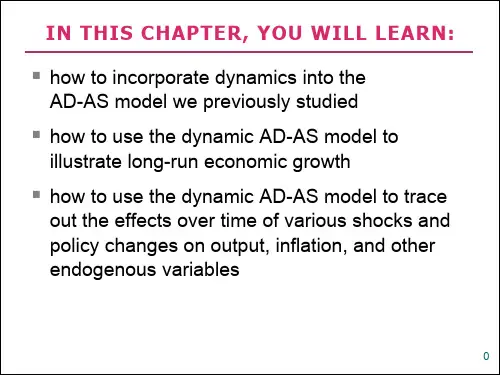
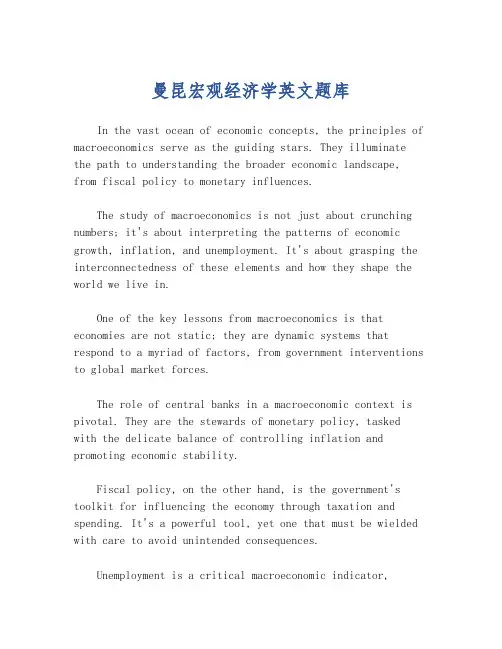
曼昆宏观经济学英文题库In the vast ocean of economic concepts, the principles of macroeconomics serve as the guiding stars. They illuminate the path to understanding the broader economic landscape, from fiscal policy to monetary influences.The study of macroeconomics is not just about crunching numbers; it's about interpreting the patterns of economic growth, inflation, and unemployment. It's about grasping the interconnectedness of these elements and how they shape the world we live in.One of the key lessons from macroeconomics is that economies are not static; they are dynamic systems that respond to a myriad of factors, from government interventions to global market forces.The role of central banks in a macroeconomic context is pivotal. They are the stewards of monetary policy, tasked with the delicate balance of controlling inflation and promoting economic stability.Fiscal policy, on the other hand, is the government's toolkit for influencing the economy through taxation and spending. It's a powerful tool, yet one that must be wielded with care to avoid unintended consequences.Unemployment is a critical macroeconomic indicator,reflecting not just the health of the job market but also the well-being of society. It's a complex issue that requires a multifaceted approach to address effectively.Inflation, the silent thief that erodes purchasing power, is a constant concern for macroeconomists. It's a delicate dance to maintain price stability while promoting economic growth.The global economy is a complex web of interdependencies. International trade and finance are integral parts of macroeconomics, showing how economies are increasingly linked in a globalized world.In conclusion, the study of macroeconomics is a journey through the intricate workings of economies. It's a fieldthat demands a deep understanding of both theory and practice, with implications that reach far beyond the classroom intothe real world.。

宏观经济学原理(第七版)曼昆-名词解释(带英文)宏观经济学原理曼昆名词解释微观经济学(microeconomics),研究家庭和企业如何做出决策,以及它们如何在市场上相互影响。
宏观经济学(macroeconomics),研究整体经济现象,包括通货膨胀、失业和经济增长。
国内生产总值GDP(gross domestic product),在某一既定时期,一个国家内生产的所有最终物品与服务的市场价值。
消费(consumption),家庭除购买新住房之外,用于物品与服务的支出。
投资(investment),用于资本设备、存货和建筑物的支出,包括家庭用于购买新住房的支出。
政府购买(government purchase),地方、州和联邦政府用于物品与服务的支出。
净出口(net export),外国人对国内生产的物品的支出(出口),减国内居民对外国物品的支出(进口)。
生产。
真实GDP(real GDP),按不变价格评价的物品与服务的生产。
(总之,名义GDP是用当年价格来评价经济中物品与服务生产的价值,真实GDP是用不变的基年价格来评价经济中物品与服务生产的价值。
)GDP平减指数(GDP, deflator),用名义GDP与真实GDP的比率乘以100计算的物价水平衡量指标。
消费物价指数CPI(consumer price index),普通消费者所购买的物品与服务的总费用的衡量指标。
通货膨胀率(inflation rate),从前一个时期以来,物价指数变动的百分比。
生产物价指数(producer price index),企业所购买的一篮子物品运服务的费用的衡量指标。
指数化(indexation),根据法律或合同按照通货膨胀的影响,对货币数量的自动调整。
名义利率(nominal interest rate),通常公布的、未根据通货膨胀的影响,校正的利率。
真实利率(real interest rate),根据通货膨胀的影响校正过的利率。
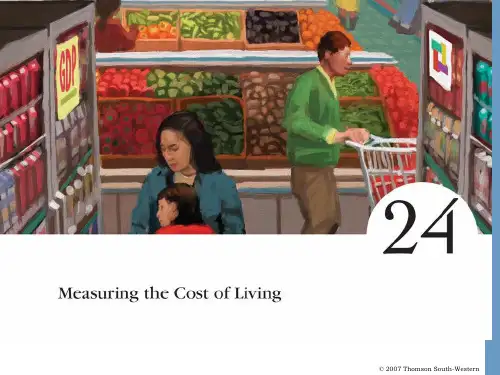
CHAPTER 23: MEASURING A NATION’S INCOMETrue/FalseIndicate whether the statement is true or false.1. T he circular flow diagram describes all transactions between households and firms in a simpleeconomy and shows the equality of expenditures and income.ANSWER: TPOINTS: 0 / 12. G ross domestic product includes most items produced and sold illicitly.ANSWER: FPOINTS: 0 / 13. N et national product is the total in come of a nation’s residents minus losses from depreciation.ANSWER: TPOINTS: 0 / 14. D isposable personal income is the income that households and unincorporated business haveleft after satisfying all their obligations to the government. It equals personal income minuspersonal taxes and certain non-tax payments to government.ANSWER: TPOINTS: 0 / 15. T he purchase of new houses by households is included in the calculation of personalconsumption expenditures of GDP.ANSWER: FPOINTS: 0 / 1Multiple ChoiceIdentify the choice that best completes the statement or answers the question.1. W hen GDP falls,a. income and expenditure must both fall.b. income and expenditure can both rise.c. income must fall, but expenditure may rise or fall.d. expenditure must fall, but income may rise or fall.ANSWER: APOINTS: 0 / 12. I ncome equals expenditure becausea. firms always pay out all their revenue as income to someone.b. each time a sale is made, there is a buyer and a seller.c. households own the factors of production used to generate incomes.d. All of the above are correct.ANSWER: BPOINTS: 0 / 13. I f a province makes the production and sale of illicit drugs legal, then GDPa. must increase.b. must decrease.c. wouldn't change.d. may increase or decrease.ANSWER: APOINTS: 0 / 14. W hen a government provides subsidies to encourage growth of small businesses, the subsidieswoulda. be included in GDP because they are invested by businesses.b. be included in GDP because they are a form of government spending.c. not be included in GDP because they are transfer payments.d. may or may not be included in GDP, depending on how the funds are used.ANSWER: CPOINTS: 0 / 15. D iesel fuel isa. always considered a final good.b. counted as an intermediate good if a company uses it to provide transportation services.c. counted as a final good if a farmer uses it to run a tractor to grow crops.d. Both b and c are correct.ANSWER: BPOINTS: 0 / 16. G ross domestic producta. is the market value of all final goods and services produced within a country in a givenperiod (usually a year)b. is the income in the hands of individuals after deducting income taxes; income availableto households to spend and savec. is the value of goods and services purchased by all levels of government— federal,provincial, and local—in a given periodd. is the market value of all final goods and services produced by permanent residents of anation in a given time periodANSWER: APOINTS: 0 / 17. M acroeconomics is that branch of economics that studiesa. the conditions of individual marketsb. the influence of governments on individual marketsc. economy-wide phenomenad. only the private sector of the economyANSWER: CPOINTS: 0 / 18. S uppose that nominal GDP is $6,000 billion and real GDP is $3,000. What is the GDP pricedeflator?a. 125b. 150c. 200d. 250ANSWER: CPOINTS: 0 / 19. T he purchase of final goods and services by households is calleda. investmentb. public sector expenditurec. consumptiond. net exportsANSWER: CPOINTS: 0 / 110. I nvestment is the purchase of capital equipment, inventories, anda. structuresb. non-durable goodsc. depreciationd. import investmentANSWER: APOINTS: 0 / 111. T ransfer paymentsa. are included in GDP because they are forms of incomeb. are included in GDP because goods and services have been produced in the transferc. are NOT included in the GDP because goods and services have not been produced inthe transferd. are included in GDP because they represent the production of transfers of goods andservices to foreign countriesANSWER: CPOINTS: 0 / 112. W hich of the following would be considered consumption expenditure?a. The Smiths buy a home built in 1990.b. The federal government pays the salary of a captain in the Armed Forces.c. The Hostlers buy a new car that was manufactured in Germany.d. The government buys food for its armed forces.ANSWER: CPOINTS: 0 / 113. T he method that measures GDP in relationship to the size of the population is calleda. GNPb. worker GDPc. GDP per persond. capital GDPANSWER: CPOINTS: 0 / 114. T he components of GDP area. C + I + Gb. NX + G + Cc. C + G + NXd. C + I + G + NXANSWER: DPOINTS: 0 / 115. S uppose nominal GDP is $7700 and the GDP deflator is 110. Real GDP isa. $7700b. $7000c. $847,000d. $8470ANSWER: BPOINTS: 0 / 1Short Answer1. W hat are the components of gross domestic product (GDP)?RESPONSE:ANSWER: The components of GDP are: (1) consumption spending by households on goods and services, with the exception of purchases of new housing; (2) Investmentspending on capital equipment, inventories, and structures, including householdpurchases of new housing; (3) government purchases or spending on goods andservices by the local, provincial, and federal levels governments; and (4) netexports which is spending on domestically produced goods and services byforeigners (exports) minus spending on foreign goods and services by domesticresident (imports).POINTS: -- / 12. D ifferentiate between gross domestic product (GDP) and gross national product (GNP).RESPONSE:ANSWER: GDP is the value of all final goods and services produced within a country in a given year; while GNP is the total income earned by a nation’s permanent residents ornationals (that is, Canadians). GNP differs from GDP by including income thatcitizens of the nation (Canada) earned aboard, and excluding income thatforeigners earn in the particular country (E.g. in Canada).POINTS: -- / 13. D ifferentiate between real GDP and nominal GDP.RESPONSE:ANSWER: Nominal GDP is the value of all final goods and services produced within a country in a year and valued at current prices; and real GDP is the GDP valued at constantbase year prices. Real GDP is not affected by changes in the level of prices, so itreflects only changes in the amounts being produced.POINTS: -- / 14. E xplain why GDP is not considered a perfect measure of well- being?RESPONSE:ANSWER: GDP is not considered a perfect measure of well-being because some of thefactors that contribute to a good life are omitted. These would include: leisure time,the quality of the environment, the distribution of income, and the production ofgoods and services that did not pas through the market (for example, houseworkdone by the homemaker, and volunteer work)POINTS: -- / 15. H ow do economists measure economic growth?RESPONSE:ANSWER: Economists measure economic growth as the percentage change in real GDP from one period to another. This is because changes in real GDP reflect only changes inthe amounts being produced.POINTS: -- / 1CHAPTER 24: MEASURING THE COST OF LIVINGTrue/FalseIndicate whether the statement is true or false.1. T he GDP deflator reflects the prices of goods and services bought by consumers, and the consumerprice index reflects the price of all final goods and services produced domestically.ANSWER: FPOINTS: 0 / 12. T he consumer price index compares the price of a fixed basket of goods and services to the price ofthe basket in the base year. On the other hand, the GDP deflator compares the price of currently produced goods and services to the price of the same goods and services in the base years.ANSWER: TPOINTS: 0 / 13. I ndexation refers to the automatic correction of a dollar amount for the effects of inflation by law orcontract.ANSWER: TPOINTS: 0 / 14. L ong term contracts between firms and unions will sometimes include partial or complete indexationof the wage to the consumer price index. This is called a cost-of-living allowance clause.ANSWER: TPOINTS: 0 / 15. T he core inflation rate is the consumer price index with the exclusion of the most volatilecomponents such as energy and food.ANSWER: TPOINTS: 0 / 1Multiple ChoiceIdentify the choice that best completes the statement or answers the question.1. I n the CPI, goods and services are weighted according toa. how much a typical consumer buys of each item.b. whether the items are necessities or luxuries.c. how much of each item is produced in the domestic economy.d. how much is spent on them in the national income accounts.ANSWER: APOINTS: 0 / 12. B y not taking into account the possibility of consumer substitution, the CPIa. understates the standard of living.b. overstates the cost of living.c. neither overstates nor understates the cost of living.d. doesn't accurately reflect the cost of living, but it is unclear if it overstates or understates thecost of living.ANSWER: BPOINTS: 0 / 13. I f the prices of Brazilian-made shoes imported into Canada increases, thena. both Canada’s GDP deflator and it’s consumer price index will increase.b. neither Canada’s GDP deflator nor it’s consumer pri ce index will increase.c. Canada’s GDP deflator will increase but its CPI will not increase.d. Canada’s consumer price index will increase, but its GDP deflator won’t change.ANSWER: DPOINTS: 0 / 14. I f increases in the prices of Canadian car insurance causes the CPI to increase by 3 percent, theGDP deflator will likely increase bya. more than 3 percent.b. 3 percent.c. less than 3 percent.d. All of the above are correct.ANSWER: CPOINTS: 0 / 15. T he real interest rate tells youa. how quickly your savings account will grow.b. how quickly the purchasing power of your savings account will grow.c. the size of your savings account.d. the purchasing power of your savings account.ANSWER: BPOINTS: 0 / 16. I nflation refers toa. a temporary increase in the price level due to higher tax ratesb. a large increase in food and gasoline pricesc. a situation in which the economy's overall price level is risingd. an increase in the purchasing power of the dollarANSWER: CPOINTS: 0 / 17. I f nominal interest rates increase from 8 percent to 10 percent while inflation increases from 3percent to 12 percenta. the real interest rate falls from 5 percent to –2 percentb. the real interest rate rises from –2 percent to 5 percentc. the real interest rate falls from 8 percent to 12 percentd. the real interest rate rises from 8 percent to 12 percentANSWER: APOINTS: 0 / 18. I f the nominal rate of interest is 10 percent and the rate of inflation is 3 percent, what is the real rateof interest?a. 13 percentb. 7 percentc. 3 percentd. –7 percentANSWER: BPOINTS: 0 / 19. T he consumer price index:a. measures price changes of raw materialsb. adjusts all prices of goods and services for five-year periodsc. measures the cost of goods and services bought by a typical consumerd. cannot measure price changes of intangible production such as servicesANSWER: CPOINTS: 0 / 110. I f the consumer price index (CPI) at the end of 1996 was 125 and the CPI at the end of 1997 was131, then the rate of inflation during 1997 wasa. zero – prices were stable during 1997b. 4.8 percentc. 6.0 percentd. 125 percentANSWER: BPOINTS: 0 / 111. F rank's nominal income in 1998 is $45,000. Suppose the CPI in 1998 is 150. What is Frank's realincome?a. $51,750b. $45,000c. $38,250d. $30,000ANSWER: DPOINTS: 0 / 112. A change in the price of imports bought by consumers will bea. reflected in the GDP deflatorb. reflected in GDPc. reflected in the CPId. reflected in net national incomeANSWER: CPOINTS: 0 / 113. A ll of the following but one are problems associated with the CPIa. substitution biasb. the introduction of new goods and servicesc. unmeasured quality changesd. The CPI is not based on a fixed basket of goods and servicesANSWER: DPOINTS: 0 / 114. W hich of the following is correct?a. The CPI is not based on a fixed basket of goods and services.b. The GDP deflator reflects the prices of all domestically produced goods and services.c. The GDP deflator is based on a fixed basket of goods and services.d. The GDP deflator is subject to substitution bias.ANSWER: BPOINTS: 0 / 115. T he inflation ratea. is a measure of the cost of a basket of goods and services bought by firmsb. is the absolute change in prices between yearsc. is the percentage change in the price index from the preceding periodd. measures changes in incomes from one year to the nextANSWER: CPOINTS: 0 / 1Short Answer1. W hat is the consumer price index (CPI)? What are the three major items included in the CPI?RESPONSE:ANSWER: The CPI is a measure of the overall cost of the goods and services bought by a typical consumer. The three major items included in the CPI are shelter, transportation andfood.POINTS: -- / 12. H ow is the CPI computed?RESPONSE:ANSWER: First the basket of goods and services must be determined and also the relative importance of the various items to be included in the basket. Then the prices of thevarious items in the basket are determined. The cost of the basket is then determinedusing the data on prices and quantity. The base year is chosen, and the index for thebase year is computed using the quantities in the basket and the base year prices.The index is calculated by taking the price of the basket in the each year and dividingthis by the price of the basket in the base year. This ratio is then multiplied by 100. POINTS: -- / 13. D ifferentiate between the nominal rate of interest and the real rate of interest.RESPONSE:ANSWER: The nominal interest rate is the interest rate as usually reported without a correction for the effects of inflation. The real interest rate is the interest rate corrected for theeffects of inflation. The real interest rate = nominal interest rate minus the inflationrate.POINTS: -- / 14. W hat is meant by the inflation rate? If the CPI in 1996 was 107.6 and in 1995 was 105.9, calculatethe inflation rate for 1996.RESPONSE:ANSWER: The inflation rate is the percentage change in the price index from the preceding period. The inflation rate for 1996 would be:POINTS: -- / 15. W hat are the problems associated with using the consumer price index to measure the cost ofliving?RESPONSE:ANSWER: The problems are: (1) Prices do not change proportionately. Consumers respond by buying less of the goods whose prices have risen by large amounts and by buyingmore of the goods whose price have risen by less, or even fallen. The index iscomputed using a fixed basket of items, so theses changes in quantity would not bereflected in the basket. This is referred to as the substitution bias. (2) The CPI isdeveloped using a fixed basket of goods and services, when new products areintroduced during the time period that a particular fixed basket is being used, thesenew products will not be included in calculation of the index. (3) The CPI does notmeasure quality changes. If the quality of a good deteriorates from one year to thenext, the value of the dollar falls, even if the price of the good stays the same.Likewise, if the quality of the good increases from one year to the next, the value of adollar also rises. Statistics Canada will try to adjust the price of the good to account forthe quality change, but it is very difficult to measure quality.POINTS: -- / 1CHAPTER 25: PRODUCTION AND GROWTHTrue/FalseIndicate whether the statement is true or false.1. O ne way to raise future productivity is to invest less current resources in the production of capital.ANSWER: FPOINTS: 0 / 12. D iminishing returns occur when the benefits from an extra unit of output declines as the quantityof output declines.ANSWER: FPOINTS: 0 / 13. M althusian theory states that an ever-increasing population would continually strain society’sability to provide for itself. This doomed human beings to forever live in poverty.ANSWER: TPOINTS: 0 / 14. P roductivity growth is measured by real output per worker.ANSWER: TPOINTS: 0 / 15. T he primary reason that living standards are higher today than they were a century ago is thattechnological knowledge has advanced.ANSWER: TPOINTS: 0 / 1Multiple ChoiceIdentify the choice that best completes the statement or answers the question.1. O f the following countries, which grew the slowest over the last 100 years?a. Brazil.b. Mexico.c. Singapore.d. United States.ANSWER: DPOINTS: 0 / 12. O n average, each year of schooling raises a person's wage in Canada by abouta. 3 percent.b. 10 percent.c. 15 percent.d. 25 percent.ANSWER: BPOINTS: 0 / 13. T he primary reason that Canadian living standards are higher today than they were a century agois thata. more productive natural resources have been discovered.b. physical capital per worker has increased.c. technological knowledge has increased.d. human capital has increased.ANSWER: CPOINTS: 0 / 14. M any countries in Africa have low growth rates. This is partly due toa. few natural resourcesb. high trade barriers.c. low incomes, making it very difficult for them to grow.d. All of the above are correct.ANSWER: BPOINTS: 0 / 15. A government can encourage growth and, in the long run, raise the economy’s standard of livingby encouraginga. population growth.b. consumption spending.c. saving and investment.d. trade restrictions.ANSWER: CPOINTS: 0 / 16. D iminishing returns is the notion thata. as the stock of capital ages, the extra output produced decreasesb. as the stock of capital is increased, the extra output produced from an additional unit ofcapital fallsc. as resources are used to produce capital goods, fewer additional capital goods can beproducedd. you always get what you pay forANSWER: BPOINTS: 0 / 17. C ompared with richer countries, poorer countries are generally characterized bya. high real GDP per personb. political stabilityc. rapid population growthd. strongly enforced property rightsANSWER: CPOINTS: 0 / 18. W hich one of the following countries would most likely be considered a poorer nation, using realGDP/person?a. Canadab. Germanyc. Japand. IndiaANSWER: DPOINTS: 0 / 19. W hich of the following factors would be most likely to encourage capital formation in a poorernation?a. the expectation of sustained high rates of inflation in the futureb. the expectation that property rights will remain securec. the expectation that a struggle between capitalist and socialist forces will lead to majorstructural change in the economyd. an increase in corporate taxes in order to finance an expanded government welfareprogramANSWER: BPOINTS: 0 / 110. W hich of the following is most likely to cause the productivity of labour to increase?a. higher money wage ratesb. a higher rate of investment in human and physical capitalc. more flexible working hours and improved retirement plansd. none of the aboveANSWER: BPOINTS: 0 / 111. S uppose that factory output rose from 50,000 units to 55,000 units while labour hours rose from1100 to 1200. Which of the following is true?a. Labour productivity remained unchanged.b. Labour productivity increased slightly.c. Labour productivity decreased slightly.d. Labour productivity increased sharply.ANSWER: BPOINTS: 0 / 112. W hich of the following would be most likely to cause the real income per person of poorercountries to rise?a. a more rapid population growthb. a rapid rate of inflationc. an international minimum-wage lawd. an increase in foreign investment that enhanced the productivity of the labour forceANSWER: DPOINTS: 0 / 113. I f a production function has constant returns to scale, then:a. doubling inputs will double output.b. doubling inputs will triple output.c. doubling inputs will cause output to increase, but the increase in output will be less thanthe increase in inputs.d. doubling inputs will decrease output.ANSWER: APOINTS: 0 / 114. T he most important source of rising living standards over time is:a. the increase in the size of the labour force.b. the increase in the labour force participation rate.c. the increase in productivity.d. the increase in human capital—the skills embodied in the work force.ANSWER: CPOINTS: 0 / 1Short Answer1. W hat is productivity and why is it important?RESPONSE:ANSWER: Productivity is the amount of goods and services produced from each hour of a worker’s time. It is the major determinant of the standard of livi ng of a country.POINTS: -- / 12. H ow is productivity determined?RESPONSE:ANSWER: Productivity is determined by a country’s physical capital, human capital, natural resources and technological knowledge.POINTS: -- / 13. W hat is the World Bank and what are its functions?RESPONSE:ANSWER: The World Bank is an international organization that among other thingsencourages the flow of capital to poor countries. It obtains funds from the world’sadvance counties and loans them to less developed countries so that they caninvest in capital infrastructure. The World Bank offers advice to developingcountries on how the funds might best be used.POINTS: -- / 14. W hat are property rights? What role does property rights play in economic growth?RESPONSE:ANSWER: Property rights refer to the ability of people to exercise authority over the resources they own. There must be an economy-wide respect for property rights for the pricesystem or the free market to work. Lack of respect for property rights or theenforcement of property rights would not only cause political instability but wouldalso discourage savings and investment. These are necessary for economicgrowth.POINTS: -- / 15. D ifferentiate between inward-oriented policies and outward-oriented policies.RESPONSE:ANSWER: Inward-oriented policies are aimed at raising productivity and living standards withina county by avoiding interaction with the rest of the world. This approach involvesthe protection of domestic industries to allow them to develop and grow withoutcompetition from foreign firms. Outward-oriented policies are designed to integratecountries into the world economy as international trade is considered to be a factorin generating economic growth.POINTS: -- / 1CHAPTER 26: SAVING, INVESTMENT, AND THE FINANCIAL SYSTEMTrue/FalseIndicate whether the statement is true or false.1. P rivate savings are the tax revenue that the government has left after paying for its spending; andpublic savings is the income that households have left after paying for taxes and consumption.ANSWER: FPOINTS: 0 / 12. A budget deficit is an excess of tax revenue over government spending; and a budget surplus is ashortfall of tax revenue from government spending.ANSWER: FPOINTS: 0 / 13. A budget surplus decreases the supply of loanable funds, increases the interest rate, andstimulates investment.ANSWER: FPOINTS: 0 / 14. T he financial system is the group of institutions in the economy that help to match one person’ssavings with another person’s investment.ANSWER: TPOINTS: 0 / 15. A mutual fund is an institution that sells shares to the public and uses the proceeds to buy aselection, or portfolio, of various types of stocks, bonds, or both stocks and bonds.ANSWER: TPOINTS: 0 / 1Multiple ChoiceIdentify the choice that best completes the statement or answers the question.1. W hich of the following is correct?a. Lenders buy bonds and borrowers sell them.b. Long-term bonds usually pay a lower interest rate than do short-term bonds becauselong-term bonds are riskier.c. Junk bonds refer to bonds that have been resold many times.d. None of the above are correct.ANSWER: APOINTS: 0 / 12. I n a closed economy, national saving equalsa. investment.b. income minus the sum of consumption and government expenditures.c. private saving plus public saving.d. All of the above are correct.ANSWER: DPOINTS: 0 / 13. I f the current market interest rate for loanable funds is below the equilibrium level, then there is aa. shortage of loanable funds and the interest rate will rise.b. surplus of loanable funds and the interest rate will rise.c. shortage of loanable funds and the interest rate will fall.d. surplus of loanable funds and the interest rate will fall.ANSWER: APOINTS: 0 / 14. S uppose that Parliament were to introduce a new investment tax credit. What would happen in themarket for loanable funds?a. The demand for loanable funds would shift left and interest rates fall.b. The demand for loanable funds would shift right and interest rates rise.c. The supply of loanable funds would shift left and interest rates rise.d. The supply of loanable funds would shift right and interest rates fall.ANSWER: BPOINTS: 0 / 15. I f Canada increases its budget deficit, it will reducea. private saving and so shift the supply of loanable funds left.b. investment and so shift the demand for loanable funds left.c. public saving and so shift the supply of loanable funds left.d. None of the above are correct.ANSWER: CPOINTS: 0 / 16. C rowding out refers toa. the increase in national saving that occurs when government runs a deficitb. the decrease in the real interest rates due to government borrowingc. a reduction in investment spending resulting from government borrowingd. a decrease in consumption spending resulting from government borrowingANSWER: CPOINTS: 0 / 17. F or a bank to be profitable, the loans it makes must _____ than the _____ obtaining funds.a. cost more; price ofb. pay less interest; total revenue fromc. make more interest; total cost ofd. be less profitable; total revenue fromANSWER: CPOINTS: 0 / 18. L arge budget deficits will likelya. increase the nation's pool of savingb. decrease the nation's pool of savingc. have no impact on the nation's pool of savingd. improve the nation's trade balanceANSWER: BPOINTS: 0 / 19. T he supply curve of loanable funds isa. upward-sloping, reflecting the fact that savers need a higher rate of interest to coax theminto lending moreb. downward-sloping, reflecting the fact that savers will increase their supply for loanablefunds at lower rates of interestc. upward-sloping, reflecting the fact that savers will increase their saving at lower rates ofinterestd. None of the aboveANSWER: APOINTS: 0 / 1。
宏观经济学第十五章MEASUREING A NATION’S INCOME一国收入的衡量Microeconomics the study of how households and firms make decisions and how they interact in markets.微观经济学:研究家庭和企业如何做出决策,以及他们如何在市场上相互交易。
Macroeconomics the study of economy-wide phenomena,including inflation,unemployment,and economic growth宏观经济学:研究整体经济现象,包括通货膨胀、失业和经济增长.GDP is the market value of final goods and services produced within a country in a given period of time.国内生产总值GDP:给定时期的一个经济体内生产的所有最终产品和服务的市场价值Consumption is spending by households on goods and services, with the exception of purchased of new housing.消费:除了购买新住房,家庭用于物品与劳务的支出。
Investment is spending on capital equipment inventories, and structures, including household purchases of new housing。
投资:用于资本设备、存货和建筑物的支出,包括家庭用于购买新住房的支出.Government purchases are spending on goods and services by local, state, and federal government.政府支出:地方、州和联邦政府用于物品和与劳务的支出.Net export is spending on domestically produced goods by foreigners (exports) minus spending on foreign goods by domestic residents (imports)净出口:外国人对国内生产的物品的支出(出口)减国内居民对外国物品的支出(进口)。